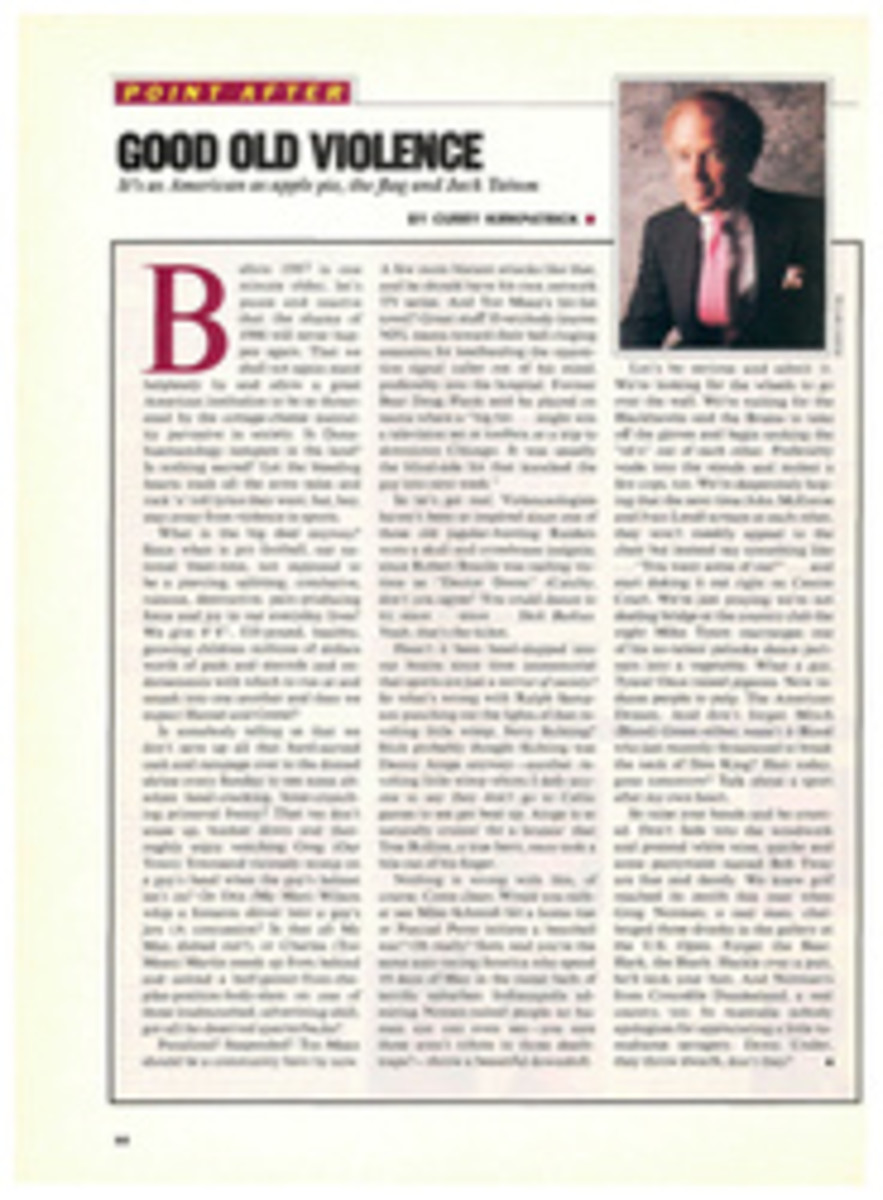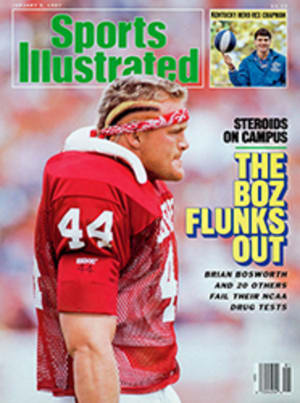
BOSWORTH FACES THE MUSIC
It was a week whenthe trees came down, one by one. They fell all across the country, and even abig fir named Brian Bosworth crashed to earth. The heavy logging of collegefootball players came courtesy of the NCAA, which last week proved itsdrug-testing program wasn't to be trifled with.
By week's end, nofewer than 21 college football players had received an NCAA New Year's greetinginforming them that they were ineligible to participate in their teams'postseason bowl games. In each case, the player tested positive for anabolicsteroids and was automatically suspended from competition for 90 days under thenew NCAA testing guidelines. In most cases the player was none too pleased.Especially Bosworth.
Ironically, theOklahoma linebacker addressed the matter in Miami, where the Herald hadreported on Dec. 21 that the latest fad among local adolescent boys is to loadup on anabolic steroids and transform themselves into thickly muscledBosworthian hulks, thus impressing their schoolmates while looking good on thebeach. It might have been a time for Bosworth to talk about the dangers ofsteroid use, inasmuch as he had just been banned from the Orange Bowl by theNCAA because of a positive test for an anabolic steroid called Deca-Durabolin.Instead, Oklahoma's fallen star spent much of his 35-minute special pressconference at a Miami hotel on Friday giving a rambling self-defense. Thejunior linebacker said the "dictatorship attitude" of the NCAA hadbanished him "to Russia" for what was, in fact, the proper use of"a legal drug" taken more than nine months earlier. Steroids, hedeclared, are not only perfectly legal but have been a part of sports for 30years, and unlike illicit drugs such as cocaine, "steroids aren'tdestroying society."
Bosworth was thebest known—and brashest—of the players ruled ineligible for bowl games as aresult of the NCAA's new ultrasensitive drug tests. The bowls affected were theRose, Orange, Citrus, Gator and Peach, and the players involved were equallydiverse: Bosworth and USC guard Jeff Bregel, both two-time All-Americas;defensive end Roland Barbay, an honorable-mention All-America from LSU;Arkansas linebacker David Dudley; Oklahoma reserve guard Gary Bennett anddefensive tackle David Shoemaker; Auburn offensive tackle Pat Johnson; Stanforddefensive tackle Tony Leiker and Cardinal offensive tackle John Zentner;Arizona State defensive tackle Richard Bear; and offensive tackle Jim Davie anddefensive end Morgan Roane from Virginia Tech.
Those 12, as wellas at least nine players who previously had tested positive at Division I-AA,II and III playoff games, (and perhaps others whose names simply haven't leakedout; teams are not compelled to release information regarding the tests) werefound to have used anabolic steroids—bulk- and muscle-building hormonederivatives.
Because it isillegal to obtain steroids without a prescription, lucrative black-marketnetworks make them readily available to the power- and weightliftingcommunities. Since many football players are deep into weight training, theyoften obtain steroids from the same dealers who service the weight- andpowerlifters. Some of these illicit steroid dealers are currently underinvestigation by the FBI and the Food and Drug Administration.
A few of theplayers caught last week said they obtained their steroids from privatephysicians. What these players obviously hadn't used was good judgment.Several, including Bosworth, had apparently been at least partly the victims ofpoor medical advice. None seemed adequately versed in the risks of steroid use(which include hypertension, cancer, sterility, liver trouble and kidney andskin disorders), yet many believed, incorrectly, that anabolic steroids are ofsignificant value in treating football-related injuries—a belief that couldn'tbe further from the truth. Not one NFL team doctor contacted by SI in a 1983survey could think of any conceivable reason to prescribe anabolic steroids forrehabilitating a football injury, and calls made to a variety of doctors lastweek underscored that earlier finding. Even as Bennett was claiming that adoctor had prescribed anabolic steroids as part of his rehabilitation fromarthroscopic knee surgery, Dr. Gerry Finerman, UCLA's team physician, wassaying, "The stories where athletes say they were given or used a smallamount to rehabilitate an injury are nonsense. There's no medical applicationfor steroids after surgery, especially after arthroscopic surgery."
Dr. Donald Catlin,the director of the UCLA drug-testing laboratory and the chairman of the USOCdrug-testing committee, said, "With steroids, the average physician cannotjustify the risks when the benefit is getting stronger and larger. In manycases where steroids are concerned, though, it's not the physician who weighsthe risks and benefits, it's the athlete."
It all made fortragicomedy. Here was Bosworth, the sides of his punk-Mohawk haircut dyed redand black, telling reporters that his only mistake was using an oil-basedsteroid that stayed in his system too long. There was his coach, Barry Switzer,saying with relief, "I'd certainly rather it be steroids than cocaine ormarijuana," after the three Sooners were ruled ineligible.
Bosworth's talewas most curious. He says he received weekly, doctor-prescribed injections ofDeca-Durabolin from early January until mid-March of 1986 to help rehabilitatethe extremely sore shoulders (so sore he couldn't even lift weights, he says)and badly bruised thigh he took away from the season-ending Orange Bowl victoryover Penn State. Yet Bosworth apparently never told team medical personnelabout the steroid treatments—"I didn't know until this positive test camethrough," says OU head trainer and drug-testing director Dan Pickett.Bosworth didn't disclose the name of the doctor who supposedly gave him theprescription and said only that the doctor carefully monitored the effects ofthe Deca-Durabolin on his blood pressure and liver and kidney functions, toprevent the development of any complications.
The doctor'sdecision to prescribe Deca-Durabolin is itself puzzling. According to itsmanufacturer, Organon Pharmaceuticals of West Orange, N.J., Deca-Durabolin isprimarily used in the treatment of cancer patients or of people who have somekinds of anemia. The authoritative Physicians' Desk Reference saysDeca-Durabolin is "probably effective" also as part of a broadtreatment program for osteoporosis and "possibly effective" for thetreatment of severe burn victims and patients coming out of major surgery.
To regular steroidusers, the drug is notorious because it lingers in the system for as long as 11months. "It's the one anabolic athletes who use steroids consider anemesis," says Tony Fitton, a former Auburn strength coach and steroidsauthority. Fitton, who served nine months in federal prisons in 1985 and 1986for, among other offenses, conspiracy to import steroids, says, "Decacreates problems because it's detectable for such a long while."
Under NCAA rulespassed in January 1986 and put into effect in August, the 22 players who playedthe most minutes during the regular season and 14 randomly chosen reserves fromeach bowl-bound team were to be tested for anabolic steroids and some 80 otherdrugs. As it turned out, only the participants in 10 major bowls were testedbecause of a shortage of top-quality labs and testing personnel. Bosworth knewhe might be tested but considered himself free of any traces of Deca-Durabolinafter he passed a steroid screening (the first in OU history) in September.Samples of 64 players were collected by OU team trainers then analyzed atIndiana University, whose drug-testing lab is one of the nation's finest.According to Pickett, two Sooners, whom he would not identify, showed positivein the September steroid screening but passed the mandatory follow-up test inOctober. "I walked right into Coach Switzer's office afterward and said,'Coach, we're ready to go to the Orange Bowl,' " says Pickett.
But it was not tobe that simple. Bosworth was laid up in the school infirmary with a stomachinfection when the NCAA testing crew arrived Dec. 10. He had a 103° fever andintravenous needles in his arms because of dehydration. Somehow, whetherbecause his urine sample was more concentrated or because the dehydrationcaused some of the remaining Deca-Durabolin to be released from storage in hisbody fat—or perhaps for some other reason—Bosworth's test showed positive, asdid Bennett's and Shoemaker's.
Bosworth wasfurious over his suspension. An outspoken critic of recreational drug use, heridiculed the NCAA for allowing an athlete to test positive for marijuanawithout penalty (some drug-testing experts worry that passive smoke might causea false positive reading, and the NCAA shares that concern) while hassling himover "what's in my system from a year ago." "[The NCAA drug] lawdidn't come into effect until August," Bosworth grumbled. "So you tellme who's at fault."
There is certainlyno evidence to suggest that Bosworth has used anabolic steroids for anythingother than rehabilitation. Deca-Durabolin, besides lingering in the system toolong to suit many athletes, does not lead to significant weight gains. "Ifhe wanted to get strong, to put on weight, to get aggressive, which is why mostfootball players take steroids in the first place, he would not have chosenDeca," says Fitton.
Still, Bosworth'sattempts at blaming the NCAA for his predicament rang hollow. Switzer says hewarned the team as early as last January about the impending steroid testing,and the 240-pound Bosworth admits taking Deca-Durabolin until mid-March.Bosworth can't find fault with the testing methodology, either: The NCAA gavemore than ample warning—having announced its testing plan last January—toathletes (including a week's notice of the exact date of prebowl testing) andhas conducted all of its tests through the Montreal and UCLA drug-testing labs,the two most advanced facilities in North America. According to steroidsexperts, the gas chromatography/mass spectrometry equipment at these labs is sosensitive—UCLA boasts that it can tell if a spoonful of sugar has been dumpedin the water of an Olympic-sized swimming pool—that there is little chance tomask steroid traces chemically in a urine sample.
John Toner, theathletics director at the University of Connecticut and the chairman of theNCAA committee on drug testing, had this assessment of the results: "I'mhappy and quite encouraged. We wanted to test at all 19 bowls, but logisticallywe just couldn't.... We will have at least one more lab next year. It'spossible we will test more bowl teams next year. Our plan is to eventually testeverybody going to a bowl game.... We haven't done enough to make anypredictions but we [Toner and the directors of the two testing labs] thoughtwe'd have a much higher incidence.... With the [publicity] this got lastJanuary, you'd have been foolish not to take heed. Yet there were gurus outthere who said you can get by the test. Well, that may be, but it'shard."
As for Bosworth,who was redshirted in 1983, he was left to ponder whether he might want to turnpro instead of returning for a fifth year. "This could hurt me for a longtime," he said. "I'm plastered across the headlines from here toRussia." While he watches Thursday's Orange Bowl from the sidelines,Bosworth will have plenty of time to think about it, just as the strict newtesting will give future college—and maybe even NFL—players something tocontemplate, too.
PHOTO
WALTER IOOSS JR.
The big bad Bosworth lost some of his glitter when the test results were analyzed.
PHOTO
JOHN BIEVER
Boz had to take his hat off to Miami's Melvin Bratton in OU's only loss during '86.
PHOTO
BILL FRAKES
Switzer (right) had a hard time figuring why Bosworth didn't listen to his warning.
PHOTO
RICHARD MACKSON
Bregel, an All-America guard, will have to pass up USC's game in the Citrus Bowl.

